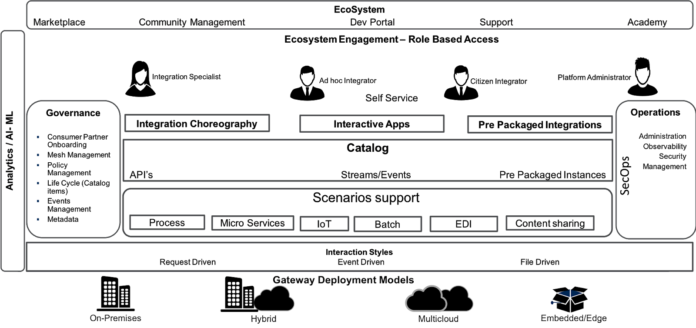iCaaS or Integration Capability as a Service

For large enterprises, integrating platforms is time-consuming and difficult. Usually APIs are used based on REST, and whilst effective, the APIs need to be created, managed, documented and updated as system integration components change. While APIs are a significant improvement over RPC, and point-to-point-integration methods, they are not easy to design, develop and maintain. Security also becomes more problematic as the potential-attack-surface area is increased and operationally supporting many platforms and tools makes management costly and cumbersome.
Integration in the cloud
There may be another way. The cloud ‘as a service’ concept has completely changed how technology is purchased and deployed within organisations. But integration – often the key to bringing digital transformation projects to fruition – is still perceived as something that needs to be done on premise, and is a process that is costly, both financially and from a resource perspective.
Now, Integration Capability as a Service (ICaaS) has emerged to speed up digital transformation and slash the time and costs involved with integration projects.
Copying behaviours
By using a pre-built, cloud-based integration platform, businesses can cut up to 90% of the prohibitive costs and time involved with integrating data sources and applications – massively reducing the reliance on specialist integration skills.
With an integration platform already in place, new integration services can be developed quickly via the deployment of configuration and transformation files.
ICaaS platforms are built on a foundation of patterns each fulfilling a specific integration behaviour – such as Assured Delivery, Request/Response, Distributed Assured Delivery and Orchestration. Pre-building these patterns, means IT teams don’t need to recreate the wheel each time.
As an example, services such as RetrieveCustomerDetails & RetrieveEmployeeDetails both adhere to the Request/Response pattern of behaviour. By deploying separate configuration data for each service to control the flow of data across the ICaaS platform, the same code base is used to ensure consistency of behaviour
To ensure consistency of operation, the same building blocks micro-services are used to construct these behavioural patterns, including:
* Configuration – used to control the process functions
* Authorisation – to determine if the user is authorised to use the service
* Validation – to ensure the input data is in the expected format
* Transformation – to convert the output data into the correct format
* Routing – to ensure the information goes to the correct consumer
* Audit – to maintain a record of the data content
* Exception Handling – to ensure all exceptions are recorded consistently
Beyond APIs
The benefit of all of this is that adding new integration services to an ICaaS platform becomes a straightforward task. All that’s needed is configuration data to define how the service works, validation information to ensure that the input data is in the expected format, and transformation details to get the data into the format required by end users.
Because it allows interfaces to be reused and it employs pre-built connectors, a cloud-based integration platform results in shorter times to production.
It also helps to protect digital assets. Data is transferred securely, and it’s easy to employ data governance and access control rules as well as keeping control of integration. The platform means that failures can be swiftly detected and monitored all the way through to resolution.
Once the learning curve is achieved, iCaaS may make life a little easier for both development and operations. iCaaS should ensure that correct data is always delivered to the appropriate person at the right time to allow them to work effectively. Cloud-based integration eases that path towards digital transformation, saving time, money and resources without compromise.
